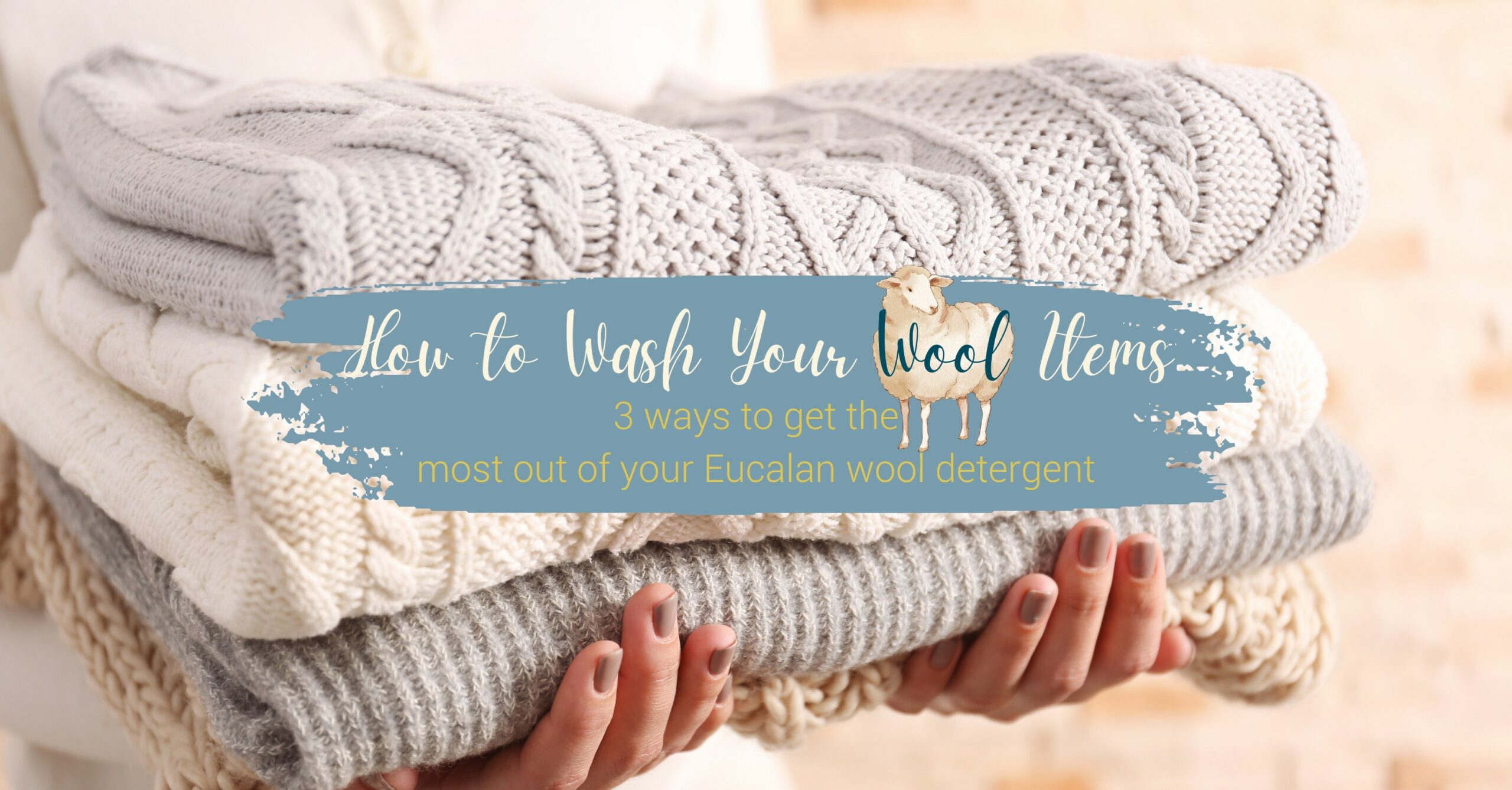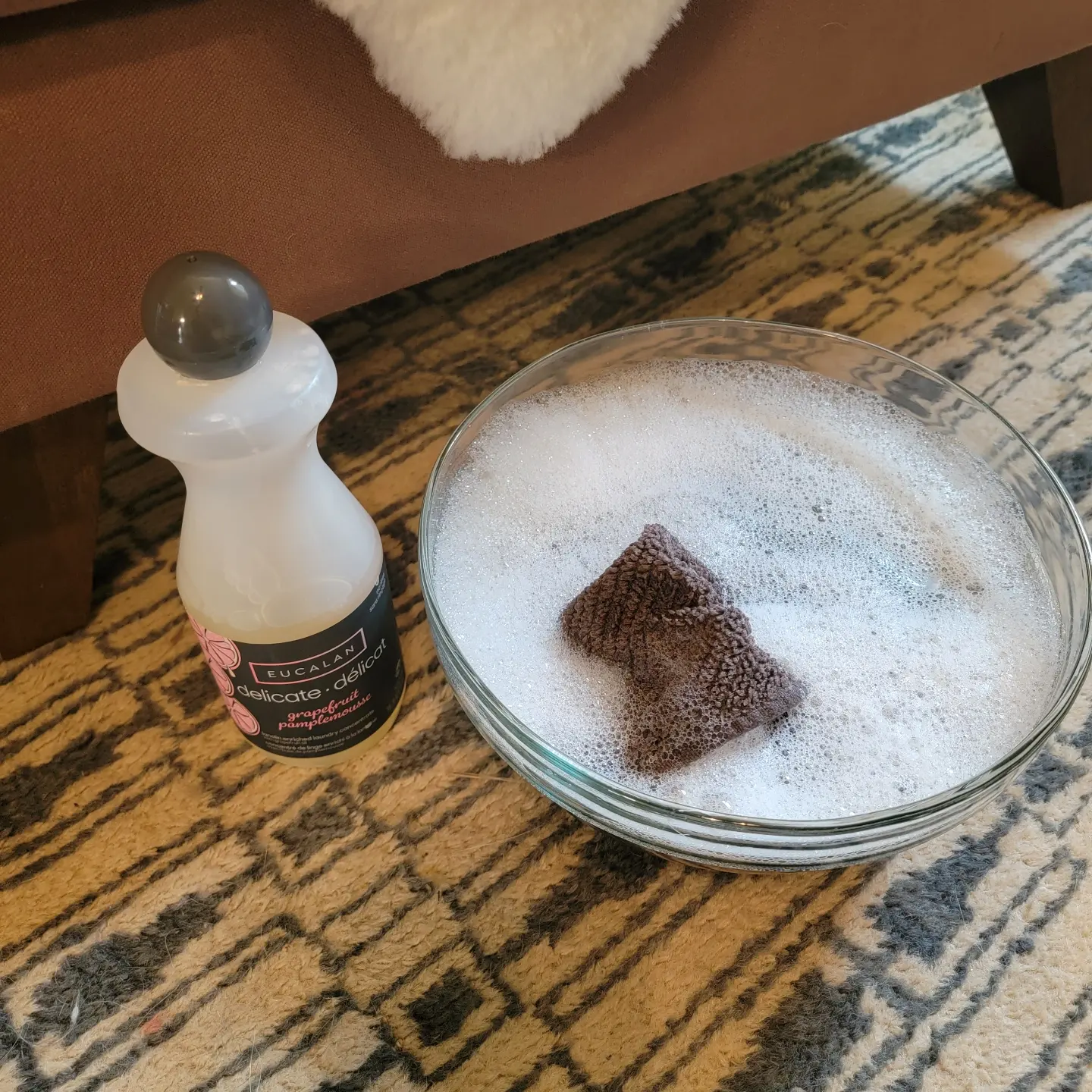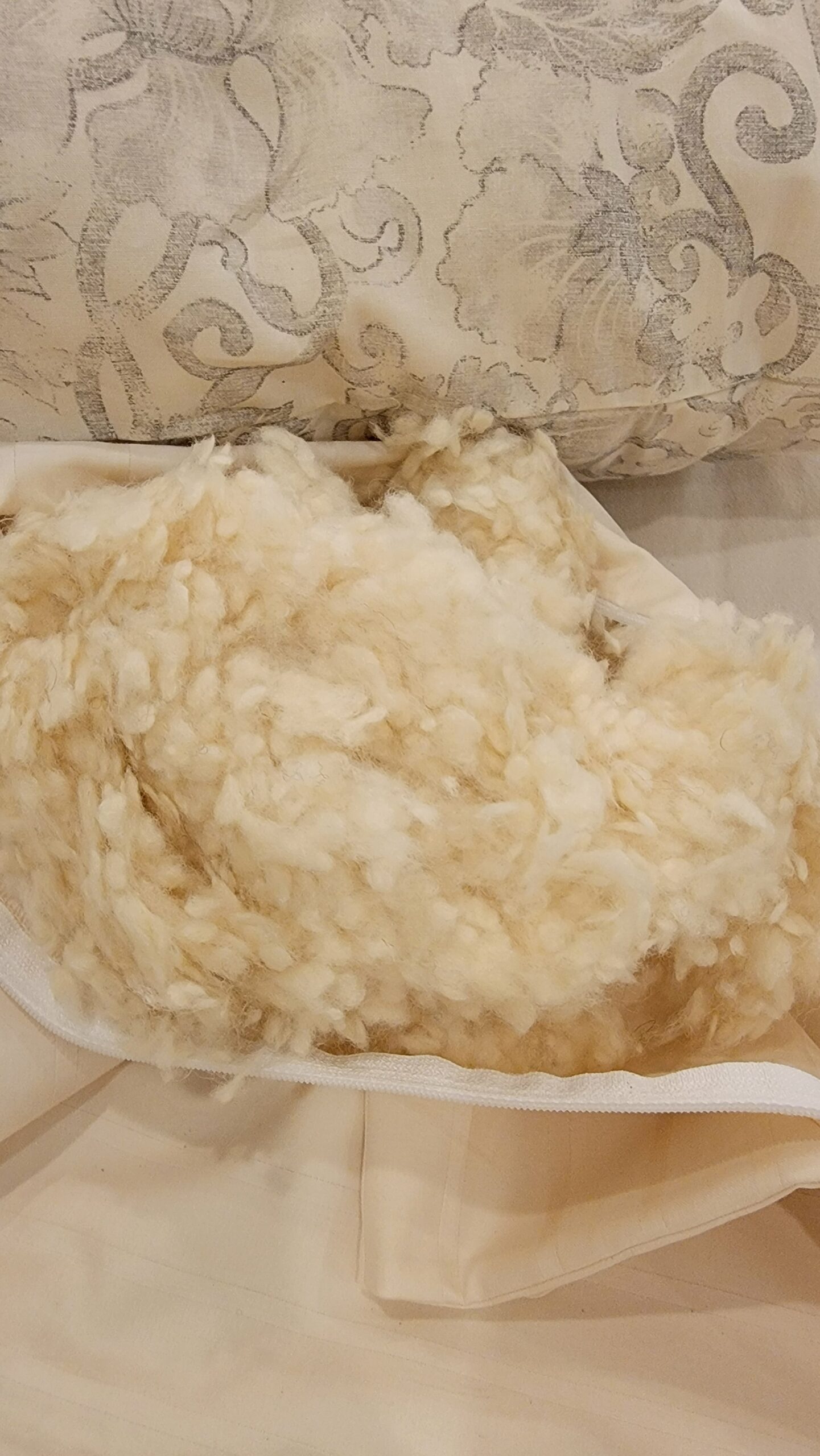How to Wash Your Wool Items
3 ways to get the most out of your Eucalan wool detergent
Clearly we’re really into wool—it’s our favorite fabric for clothing and household items, but it can be tricky to care for. Because of its unique properties, it requires special attention when it comes to washing, as traditional laundry detergents can damage or shrink the fibers. That’s why it’s important to use a wool-safe detergent when washing your woolen items.
In this article, we’ll discuss three ways to use a wool-safe detergent to care for your woolen garments and household items.

Introducing…Eucalan!
Before we begin, the most important step of all is to choose the right detergent for your woolens. We recommend Eucalan (which we sell in-store and online) because of its clean ingredients and the inclusion of lanolin, the natural oil found on wool before it has been scoured.
Avoid using traditional laundry detergents, as these can be too harsh for wool, causing the fibers to shrink, stretch, fade, or lose their shape. Sometimes regular detergent can have enzymes meant to break down organic matter such as food stains, but this can also “eat” the fibers in the wool, causing the fabric or threads to come apart. Also, make sure to carefully read the instructions on your detergent as to ensure you get the best benefit from it and to make sure not to use too much.
-
In the Laundry: The Soak Method & Machine Washing
Depending on the garments, you may want to use the Soak Method or simply wash them as you would in a machine on regular wash. Not sure which method to use? Read the label.
Typically it’s recommended to dry clean wool clothing, especially if it’s a bulky item like a wool jacket. But we’ve had excellent results with lighter items such as sweaters using the Soak Method for delicates, or Machine Wash for sturdier items such as our Icebreaker baselayers.
For anyone curious about what “tepid” water temperature means, it’s considered warmer than room temp by about 15 degrees. This will help Eucalan work best while also not being hot enough to shrink fibers or damage your items. If you’re concerned about potential damage, dissolve the Eucalan in tepid water and then allow it to cool before proceeding.
The Soak Method:
- Fill a basin such as a bathroom sink or bathtub, with tepid water (about 100°F ) and add one or two capfuls of Eucalan.
- Gently place the article to be washed in the water and swish it around. Let it soak for about 15 minutes.
- After 15 minutes or so, give the article a light squeeze to allow the soap bubbles to incorporate into the fibers. If you have a stain, apply a bit of Eucalan directly to the stain and rub it in with your fingers.
- Soak for an additional 15 minutes if the article was stained or heavily soiled. No need to rinse! The lanolin in Eucalan is low-sudsing and will protect the fibers in the article that has been washed. Then drain the basin.
- Remove the article from the basin and place flat on a clean cotton towel. Roll up the towel to remove as much of the water as possible, being careful not to twist or ring out.
- Place the article on a second clean cotton towel in a cool area with plenty of air circulation and reshape so it’s flat. Outside is fine, but be careful not to leave it out in direct sunlight for too long if the article has fabric dyes, as this may cause the color to fade. A little sunlight is great as it will naturally bleach and disinfect, but this will also happen as it air-dries.
Washing Machine:
- Allow the washing machine to fill with tepid water, add 15-30 mL/1-2 Tbs. of Eucalan per load into the fabric softener dispenser of your washing machine, and select the Rinse and Spin cycle. If your machine doesn’t have a fabric softener dispenser, simply add the Eucalan to the main drum of your machine.
- Let the water and soap get “sudsy” before adding clothing. Add your wooly articles to the machine and pause the cycle.
- Let the items soak for about 15 minutes.
- a) Bypass the rinse cycle on your machine and select the Spin Cycle. You may need to turn your machine off and then choose Spin Cycle. Remove clothing when finished and go to Step 5.
- b) If for some reason you can’t skip the Rinse Cycle and go to Spin, remove the articles from the machine and place them flat on a clean cotton towel. Roll up the towel to remove as much of the water as possible, being careful not to twist or wring out. Then proceed to Step 5.
- Place articles flat on a dry, clean cotton towel in an area with plenty of air circulation. Outside works too, but we don’t recommend direct sunlight if the article has fabric dyes, as this may cause the color to fade.
We never recommend using fabric softeners or dryer sheets, a product commonly used with wool, because of the toxic chemicals they deposit onto your clothing. The lanolin in the Eucalan should be all that your wool garments need.
Washing your woolen items with these methods will keep your clothes looking and feeling fresh, soft, and perfectly clean for many, many wearings.

2. Wool Rug Maintenance
A good wool rug is an investment that can last generations—many of the old tapestries found in historic castles and palaces are made entirely from wool and are hundreds of years old. How do these precious, ancient pieces get cleaned? You guessed it—a specialized wool detergent (and expensive machinery that is unfortunately not practical for us mortals).
For regular maintenance of your wool rugs:
- First, vacuum the rug or, if small enough, shake it outside to remove as much dirt and dander as possible.
- Grab a clean bowl and use 5mL/1 tsp of Eucalan per 4L/1G of tepid water (more for heavily soiled rugs).
- Using a clean, undyed cotton towel (or an old rag is fine), gently scrub the rug using a back-and-forth motion that is in the same direction as the warp (the lengthwise direction) of the rug.
- Let air dry completely before replacing any items or furniture that may have been on top of the rug.
Did you happen to catch our real-life mystery pink stain and coffee hazard on our Instagram Stories the other week? Sometimes a little spot treatment is necessary and you can use your Eucalan for this too!
For spot treatment of your wool rugs:
- First, vacuum your rug or remove any loose dirt.
- Then apply a small amount of Eucalan directly to the stain if it’s small, or dilute it with a little tepid water if it’s larger, like the coffee stain from our video.
- Let it sit for about 15 minutes. Then follow the maintenance instructions above.
- Prepare to be amazed.
A lot of websites recommend using dry shampoo to help clean your rug. We discourage this practice as dry shampoos vary in their ingredients and can contain harsh chemicals that may damage your wool rug (and yes, may be damaging to your hair too!). They often contain synthetic fragrances which we don’t like for the same reason we don’t like using fabric softeners or sheets.
Instead, try making your own wool rug dry shampoo! One of the basic ingredients of all dry shampoos is a common household item you probably have already—corn starch.
- Measure out about ½ cup of non-gmo cornstarch and slowly add in a few drops of Eucalan.
- Rub it around with your fingers until it looks like wet sand.
- Carefully sprinkle your new DIY dry carpet shampoo on your wool rug and let sit for about 30 minutes.
- Then vacuum it up and admire your good-as-new rug!
If you are not an owner of wool carpets or rugs and love the practicality of the washable, stain-resistant versions, consider this—synthetic carpets and rugs, while cheaper and easier to clean, contain dangerous chemicals known as PFAS, otherwise known as “forever chemicals.” NPR just featured a study on PFAS on their All Things Considered show if you’d like to learn more. These are a class of human-made chemicals that have been linked to a quickly growing list of serious medical conditions and diseases such as cancer, and their “safety” has not been adequately studied.
If a quality wool or other natural-fiber rug isn’t within your budget, try checking out antique stores or search your community marketplace. We’ve been very happy with both Pottery Barn and local artisan wool rugs in our Ashland showroom. As mentioned above, wool rugs will last longer than a lifetime so there’s bound to be a second-hand one in great condition near you that just needs a little sprucing up. And now you know how!

3. Washable Wooly Down Pillows
One of our favorite pillows is our hand-made Washable Wooly Down Pillow because it’s soft, versatile, and mimics goose-down pillows without the animal cruelty. It may seem too good to be true, but it’s also washable!
- Remove all the wooly bolus from the pillow and wash the cotton sateen cover as you would your regular linens.
- If you’re worried about wool slipping down your drain, place the wooly bolus filling inside one of our Coyuchi Extra Large cotton mesh bags.
- Then simply follow the steps for the Soak Method by hand above (don’t machine wash the wool stuffing).
- Restuff your cotton pillow cover when it’s fully dry, and your pillow will be as light and fluffy as the day you got it.
The Wooly Lifestyle
Living with wool doesn’t require much extra effort, just a bit of know-how and the right tools. By following these simple steps you can ensure your woolen investments last a lifetime and perhaps even longer. If you’re looking for more information on caring for our wool products such as mattresses, toppers, and blankets, more detailed care instructions can be found in our Product Care Guide.
Be sure to follow us on Instagram and Pinterest for more adventures in living with wool and taking good care of it. Thanks for reading our latest installment of Counting Sheep and as always—Sweet Dreams!

